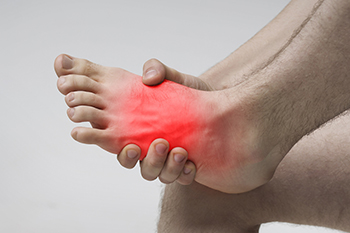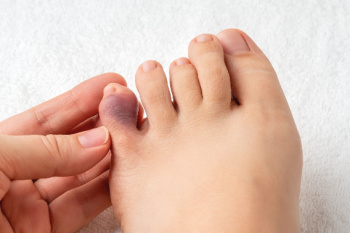Items filtered by date: November 2024
Causes and Symptoms of Foot Sprains

A foot sprain occurs when the ligaments in the foot stretch or tear, often the result of sudden twisting motions during strenuous activities or sports. Symptoms of a sprained foot include pain, swelling, bruising, and difficulty bearing weight on the affected foot. Severe sprains may produce a popping sound when the ligament tears. A podiatrist can assess the severity of a foot sprain through an exam and digital imaging. A grade 1 foot sprain involves mild stretching of the ligament, a grade 2 sprain has partial ligament tears causing joint instability, and a grade 3 sprain includes complete ligament tears and significant foot instability. Recovery times vary, with mild sprains healing within weeks, while more severe cases can require several months. Treatment may involve braces, controlled movement, and rehabilitation exercises to aid healing and restore mobility. If you believe you have sprained your foot, it is suggested that you schedule an appointment with a podiatrist for appropriate treatment methods.
Foot Pain
Foot pain can be extremely painful and debilitating. If you have a foot pain, consult with Afsaneh Latifi, DPM from Lenox Hill Podiatry. Our doctor will assess your condition and provide you with quality foot and ankle treatment.
Causes
Foot pain is a very broad condition that could be caused by one or more ailments. The most common include:
- Bunions
- Hammertoes
- Plantar Fasciitis
- Bone Spurs
- Corns
- Tarsal Tunnel Syndrome
- Ingrown Toenails
- Arthritis (such as Gout, Rheumatoid, and Osteoarthritis)
- Flat Feet
- Injury (from stress fractures, broken toe, foot, ankle, Achilles tendon ruptures, and sprains)
- And more
Diagnosis
To figure out the cause of foot pain, podiatrists utilize several different methods. This can range from simple visual inspections and sensation tests to X-rays and MRI scans. Prior medical history, family medical history, and any recent physical traumatic events will all be taken into consideration for a proper diagnosis.
Treatment
Treatment depends upon the cause of the foot pain. Whether it is resting, staying off the foot, or having surgery; podiatrists have a number of treatment options available for foot pain.
If you have any questions, please feel free to contact our office located in New York, NY . We offer the newest diagnostic and treatment technologies for all your foot care needs.
Understanding a Broken Pinky Toe

A broken pinky toe is a common injury that can happen in various ways, such as stubbing it against furniture, dropping something heavy on it, or experiencing repetitive stress from activities like running. If you have a broken pinky toe, you might experience sharp pain, swelling, bruising, and difficulty walking or wearing shoes comfortably. A podiatrist can diagnose a broken toe with a thorough physical examination and imaging tests, like X-rays, to assess the extent of the injury. For treatment, buddy taping the injured pinky toe to the adjacent toe can provide stability. In more severe cases, a special shoe may be recommended to restrict movement and protect the toe during healing. Recovery usually takes about four to six weeks, but this can vary depending on the severity of the fracture and your overall health. If you think you might have a broken pinky toe, it is suggested that you schedule an appointment with a podiatrist. They can provide the right diagnosis and treatment plan to ensure proper healing.
A broken toe can be very painful and lead to complications if not properly fixed. If you have any concerns about your feet, contact Afsaneh Latifi, DPM from Lenox Hill Podiatry. Our doctor will treat your foot and ankle needs.
What to Know About a Broken Toe
Although most people try to avoid foot trauma such as banging, stubbing, or dropping heavy objects on their feet, the unfortunate fact is that it is a common occurrence. Given the fact that toes are positioned in front of the feet, they typically sustain the brunt of such trauma. When trauma occurs to a toe, the result can be a painful break (fracture).
Symptoms of a Broken Toe
- Throbbing pain
- Swelling
- Bruising on the skin and toenail
- The inability to move the toe
- Toe appears crooked or disfigured
- Tingling or numbness in the toe
Generally, it is best to stay off of the injured toe with the affected foot elevated.
Severe toe fractures may be treated with a splint, cast, and in some cases, minor surgery. Due to its position and the pressure it endures with daily activity, future complications can occur if the big toe is not properly treated.
If you have any questions please feel free to contact our office located in New York, NY . We offer the newest diagnostic and treatment technologies for all your foot and ankle needs.
Heel Pain Can Be Treated!
Bunion Problems

A bunion is a bony bump that forms at the base of the big toe, causing the toe to shift toward the others. This misalignment often results from wearing tight or narrow shoes, although genetics, arthritis, or foot structure abnormalities can also contribute. Over time, the joint at the base of the big toe becomes swollen and painful. Symptoms include discomfort, redness, swelling, and difficulty walking, especially when wearing shoes. As the condition progresses, corns or calluses may form where the toes rub together. A podiatrist typically diagnoses bunions through a physical exam and may use X-rays to assess the severity and joint damage.Treatment can involve wearing wider shoes, using padding and orthotics to relieve pressure. In more advanced cases, surgery, called a bunionectomy, may be necessary to correct the deformity. Early intervention can help manage symptoms and prevent progression. If you have a painful bunion, it is suggested that you schedule an appointment with a podiatrist for an exam and relief options.
If you are suffering from bunion pain, contact Afsaneh Latifi, DPM of Lenox Hill Podiatry. Our doctor can provide the care you need to keep you pain-free and on your feet.
What Is a Bunion?
Bunions are painful bony bumps that usually develop on the inside of the foot at the joint of the big toe. As the deformity increases over time, it may become painful to walk and wear shoes. Women are more likely to exacerbate existing bunions since they often wear tight, narrow shoes that shift their toes together. Bunion pain can be relieved by wearing wider shoes with enough room for the toes.
Causes
- Genetics – some people inherit feet that are more prone to bunion development
- Inflammatory Conditions - rheumatoid arthritis and polio may cause bunion development
Symptoms
- Redness and inflammation
- Pain and tenderness
- Callus or corns on the bump
- Restricted motion in the big toe
In order to diagnose your bunion, your podiatrist may ask about your medical history, symptoms, and general health. Your doctor might also order an x-ray to take a closer look at your feet. Nonsurgical treatment options include orthotics, padding, icing, changes in footwear, and medication. If nonsurgical treatments don’t alleviate your bunion pain, surgery may be necessary.
If you have any questions, please feel free to contact our office located in New York, NY . We offer the newest diagnostic and treatment technologies for all your foot care needs.





